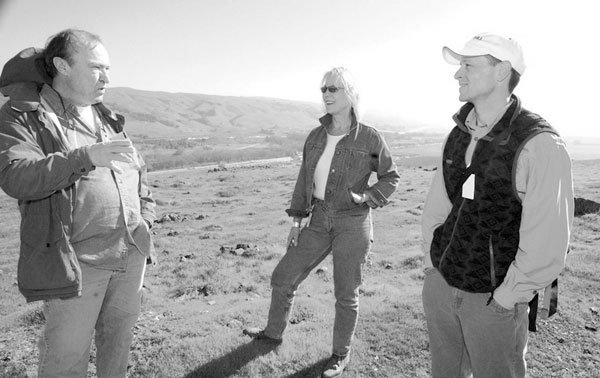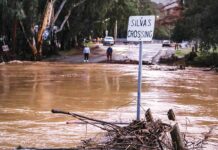Mother Nature blessed the San Francisco Bay Area with some of
the world’s best scenery, much of which is still on public view.
The area also is home to valuable plants and animals needing
reserved habitat.
Mother Nature blessed the San Francisco Bay Area with some of the world’s best scenery, much of which is still on public view. The area also is home to valuable plants and animals needing reserved habitat.
To protect these treasured lands, dedicated conservation agencies have worked to purchase and maintain open space.
Sometimes working alone, sometimes together, the result has been the preservation of hundreds of acres of picturesque and sensitive land – land that will never be built upon and that will exist for generations to enjoy.
Not all conservation efforts involve outright purchases, called ‘fee titles.’ Another concept, that of ‘conservation easements,’ offers land owners the chance to continue farming or ranching on the land. What is given up – and money does exchange hands – is the right of property owners to sell the land for development or to develop it themselves.
Thus, an agency buys the development rights, a property owner gets a financial nest egg and the land is preserved as agricultural or open space.
The Land Trust For Santa Clara County, which recently acquired 116 acres, called Tulare Hill, from Calpine, near the company’s Metcalf Energy Facility in Coyote Valley north of Morgan Hill, doesn’t just work with other land-use agencies. Working with Morgan Hill’s Wildlife Education and Rehabilitation Center (WERC), the Land Trust recently reintroduced a red-tailed hawk into the area, replacing one that was injured and died.
A $1.4 million endowment, along with a donation of 131 acres that included Tulare Hill, plus Fisher Creek and Coyote Ridge, allowed the Land Trust to protect the sensitive serpentine (a rock formation) habitat for the Bay checkerspot butterfly, its host plants and other species.
The Land Trust also received a donation of a 40-acre agricultural conservation easement along Redwood Retreat Road in Gilroy, is safeguarding 10 acres of hilly terrain near Mt. Madonna and is working with six farmers to protect 1,700 acres of farmland south and east of Gilroy.
Three Santa Clara County organizations – the Land Trust, the Open Space Authority and the Nature Conservancy – have collaborated on what the Land Trust calls “a conservation vision.” This vision sees a network of parks, preserves and working ranches in foothills on both sides of Santa Clara Valley plus preserved agricultural land on the valley floor.
The triumvirate has worked with landowners willing to sell conservation easements on large agricultural lands north of Morgan Hill, east and south of Gilroy and on ranches in the east and west foothills. The group also encourages “green” solutions to floodplain management, waterway restoration and steelhead trout habitat.
• The Pajaro Project is a partnership of the San Benito Agricultural Land Trust, The American Farmland Trust, The Nature Conservancy, the Santa Clara Valley Water District and the Land Trust For Santa Clara County. The project’s motto is “Our land, our water, our way of life.”
Together the agencies intend to preserve the region’s agricultural heritage, protect its unique scenery and working farms, maintain the area’s function as a natural floodplain, repair and protect waterways for clean water and wildlife migration plus creating places for outdoor recreation and education.
Pajaro Project area runs from just west of U.S. 101 south of Gilroy and stretches east to San Felipe Lake and Pacheco Creek in San Benito County. It extends from Uvas Creek, just north of Highway 25, to just below the Pajaro River on the southern edge.
Nancy Richardson, executive director of the Land Trust, said motorists can see the land from Highway 101 as they drive north into Gilroy along the large curving stretch of freeway. Pajaro land is mostly off to the east.
“It’s a beautiful expanse of farmland,” she said.
Richardson explained that, because the partnership spans both counties, it engages the entire watershed view.
“This is advantageous for everyone,” Richardson said.
Appropriate lands were carved off to work as preserved farmland; the flooding area was sold to the Santa Clara Valley Water District to enhance wetlands, improve water quality and reduce the flow of sediments into the Monterey Bay National Marine Sanctuary.
Other land organizations
The Santa Clara County Open Space Authority also works to purchase fee title or easements, often working with other agencies. Its latest effort is the 1.5-mile Boccardo Trail Corridor, historically part of the Miller and Harlan Ranch in San Jose’s Alum Rock Park, opened to public in 2002. The trail is open to hikers, bicyclists and equestrians and is designated as a portion of the Bay Area Ridge Trail.
The Carnadero Project, also in south Santa Clara County, is a smaller part of the Pajaro Project and will cost the Land Trust $6.35 million. It will, however, preserve 480 acres of historic farm and wetland. Again, the Land Trust will sell acreage – 198 acres – to the water district for plant and animal habitat restoration. The Land Trust will place a conservation easement on 276 acres and resell it to a farmer and expects to raise $680,000 by May 2004 to fulfill its option to buy.
“The Carnadero area now feeds into the upper Pajaro River,” said Mike DiMarco, the water district’s spokesman, “and will preserve in its natural state the upper Pajaro watershed.”
If the project is successful, he said, the area will flood in winter instead of dumping water down river into Watsonville.
• The 10-year-old San Benito County Agricultural Land Trust, works with other organizations to purchase conservation easements on important selected lands; it does not own any fee title land.
Paul Hain, president of the board, said the agency has 5,000 acres under such easements.
“The majority are in two large ranches,” Hain said. “The Cook easement, 17 miles due east and the Wilkensen easement, 20 miles east of Tres Pinos, on the border with Merced County.”
There also is a 68-acre piece of prime farmland in the San Juan Valley, known as Brandenburg, Hain said.













